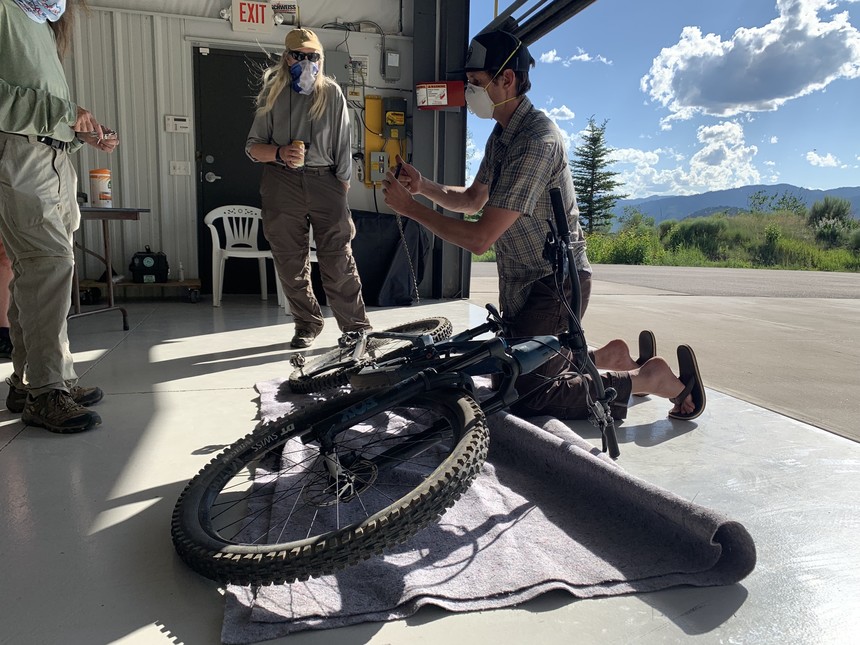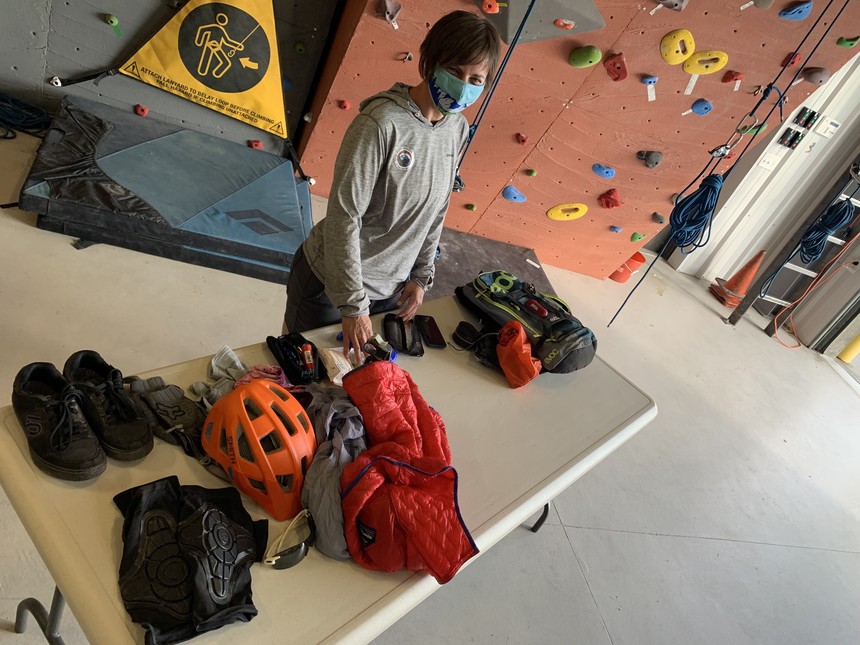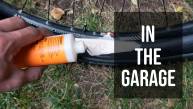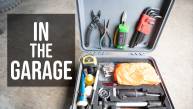 For emergencies during mountain bike riders, what should you carry and how should you carry it? Max Ritter photo.
For emergencies during mountain bike riders, what should you carry and how should you carry it? Max Ritter photo.
For this installment of In the Garage, I want to reflect on a few close calls I’ve experienced riding lately, and talk about being properly prepared for when shit hits the fan on a mountain bike ride. That can range from a flat tire, to a broken bike, all the way to an injury or a medical emergency. When we ride in the backcountry all winter long, we know that being properly prepared can make the difference between life or death, or at least between a good and a bad time in the mountains. The same holds true for any day out on the bike. Just because it's warm and sunny out shouldn't lead to us letting our guard down when riding our favorite trails in the mountains. Our local Teton County Search and Rescue Organization, in conjunction with Mountain Bike the Tetons is putting on an event at the end of the month to get you prepared for eventualities in the backcountry while biking. Check it out here.
RELATED: In the Garage - How to Adjust MTB Shifting
With mountain bike season now in full swing around the Tetons, we’ve all been putting the miles in our bike. With nice weather and amazing conditions, I know that I for sure have been riding more than I usually do. Over the last two weeks, I’ve also been involved in or witnessed several incidents in the backcountry that made me think about how well-prepared I am in a weird situation. While ideally you won’t need to call them, Liz King from TCSAR reminds us that:
The Teton County Search and Rescue Foundation works to provide community members with the skills they may need when things don't go according to plan. Basic knowledge helps people avoid panic and enables them to care for themselves, others, and gear when out recreating in places that are far from definitive care. Taking the time to learn skills and pack the right gear can and does save lives.
Last week, I left my hip pack at home and went for a ride regardless, subsequently flatting after tearing the sidewall on my rear tire. The hole was too big to fix using tire plugs, and after exhausting the two CO2 cartridges I was carrying trying to reinflate the emergency-repaired tire, I was left with the choice of walking out or riding the rest of the trail with no air in the back. Luckily, I was using a CushCore tire insert, which actually allowed me to ride the rest of this notoriously gnarly trail with a flat tire. It’s not something I would suggest trying, but it got me out of the stupidity of not carrying adequate repair supplies.
 Tony Ferlisi of MBT demonstrates how to fix a broken chain at a recent TCSAR event. Teton County Search and Rescue Foundation photo.
Tony Ferlisi of MBT demonstrates how to fix a broken chain at a recent TCSAR event. Teton County Search and Rescue Foundation photo.
Then, just a few days later on the same trail, I crashed hard and ended up breaking my full-face helmet and covering my body in scratches. I knew I had a med kit in the car, but that was still at the bottom of the hill. Again, that got me thinking about being prepared. If guides and bike patrollers are all required to ride with a med kit, why shouldn’t at least one person if every group carry one too? No matter what.
 Jen Reddy of TCSAR shows us what she carries on a ride. Teton County Search and Rescue Foundation photo.
Jen Reddy of TCSAR shows us what she carries on a ride. Teton County Search and Rescue Foundation photo.
With that in mind, here’s an outline of what any rider should carry for a day on the trails, as well as a more comprehensive list for longer rides where medical or mechanical help is more than a short push or walk away. It should go without saying that you should always wear a helmet and appropriate protective gear like knee pads.
The Pack:
Hip Pack or MTB-specific Hydration Backpack – For riding in the Tetons, I’ll typically rock a hip pack for shorter rides where I’m only bringing the essentials. Longer adventure rides - where I’m out for more than a few hours or am more than three miles from a road – warrant a bigger backpack to fit more stuff. I like EVOC’s 3L hip pack and Thule’s Rail 12 Pro backpack (which has a removable back protector), but any bag that’s comfortable and can fit stuff will do.
 Honestly, size does matter. Max Ritter photo.
Honestly, size does matter. Max Ritter photo.
Cell Phone:
Bring your phone on your ride. Every single time. If you don’t want to be distracted by it, turn it off and put it in your pack, but trust me, you’ll want it to call for help in an emergency. Most bike trails are close enough to civilization that you’ll get service.
Repair Kit:
Much of this repair kit can actually be strapped to your bike frame using a ski strap or something more reliable like the Backcountry Research Mutherload Strap.
Spare Tube – Make sure it’s right size for your wheel. If you want to go ultralight, check out Tubolito’s emergency tubes.
Tire Levers – You won’t be able to get your tire off the rim without at least one tire lever.
CO2 Inflator + Cartridges/ Hand Pump – CO2 is a fickle beast, and has proven unreliable on numerous occasions, so I’ve started to carry a hand pump instead. I like the Crankbrothers Klic Hand Pump.
Multitool with Chaintool – A multitool should be your best friend, as something like Crankbrothers M19 has just about everything you could need for trailside repairs.
 All those tools easily fit into a 3L hip pack with room to spare, the rest goes on the bike. Max Ritter photo.
All those tools easily fit into a 3L hip pack with room to spare, the rest goes on the bike. Max Ritter photo.
Tire Plugs – For small punctures in a tubeless tire, rubber tire plugs are often the easiest solution to fixing a flat. If the hole is too big, it’s time to pop in a tube.
Extra Chain Link – Broken chains are a real thing and having an extra quicklink (make sure it matches your chain) is the easiest fix.
Zip Ties – Zip ties are like duct tape on mountain bikes: they fix everything.
Medical Kit:
Small but Comprehensive First Aid Kit: The most common injuries sustained biking are abrasions (sliding across the dirt on bare skin will lead to those, trust me), so be ready to treat those with bandages/wound dressings, antiseptic spray or cream, and some medical tape. Additionally, I carry some NSAIDs like ibuprofen, and antihistamine allergy meds (allergy incidents, especially during the spring are also a common ride-ender).
SAM splint: On longer riders when I’m carrying backpack, I like to carry a SAM splint and either tape or ski straps to secure it. This can be used to splint a broken bone or a sprained ankle sustained during a crash, and can get a patient out of the woods. As an arm splint, folding a riding jersey or even using that spare tube can secure an arm to stabilize a broken collarbone.
Other Stuff:
Snacks: Whatever you like to eat. I like sugary snacks like gummy bears or any of the baked goods my girlfriend makes me.
Water: Pop a bottle on your frame and carry some in your pack, and you won’t regret being hydrated on any ride. I like to add electrolyte powder to my frame bottle to mix things up.
Bike Light: Sometimes those after work rides do turn into an epic, and riding in the dark is a bad idea without a headlamp or a bike light. Make sure it's charged.
Extra Layer: This might not be necessary during the hot summer months, but for early and late season riding, that extra layer could provide that much needed warmth on long rides.












